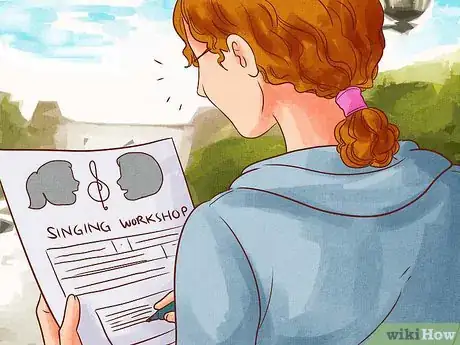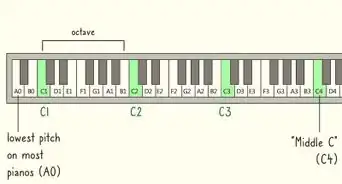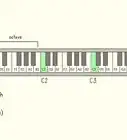This article was co-authored by Annabeth Novitzki. Annabeth Novitzki is a Private Music Teacher in Austin, Texas. She received her BFA in Vocal Performance from Carnegie Mellon University in 2004 and her Master of Music in Vocal Performance from the University of Memphis in 2012. She has been teaching music lessons since 2004.
wikiHow marks an article as reader-approved once it receives enough positive feedback. This article received 13 testimonials and 88% of readers who voted found it helpful, earning it our reader-approved status.
This article has been viewed 217,297 times.
Some singers can hit breathtaking high notes, while others can dig deep for soulful lows. A lucky few can do both with ease! A singer's range is the spectrum of notes that they can sing comfortably and clearly. Finding your range is easy — all you'll need is a musical instrument like a piano (or a digital alternative) to give you a few reference tones and you'll know your range within a minute or 2.
Steps
Using a Piano or Keyboard
-
1Press middle C (C4) on the keyboard. Because it can play a relatively wide range of notes perfectly in tune, a piano (or an electric keyboard) is usually the most useful instrument for finding your vocal range. Start by pressing the note middle C (also called C4) on the keyboard. Note that you won't need to know how to play the piano to use this method of finding your vocal range.
- If you're not familiar with the keys on a piano, middle C is the fourth C natural note counting from the left side of the keyboard. In other words, it is the fourth white key that is to the left of 2 black keys. Usually, this is right in the middle of the keyboard, under the manufacturer's name or logo.[1]
- If you're not sure whether you're using the right note, consider using a digital middle C reference tone (which can be found on YouTube, etc.) to help you find it.
- Starting at middle C is a good idea because it's contained in all of the traditional voice classes (i.e., bass, baritone, tenor, alto, soprano.) However, middle C falls at the top of a bass's vocal range and at the bottom of a soprano's, so if you have an exceptionally low or high voice, you may not be able to hit it. This is OK — simply start at a more comfortable note instead.
-
2Sing the note, matching your pitch carefully. When you've found middle C, sing the note out loud. Use a good amount of air support — you don't have to belt the note, but you need to sing it (and all of the other notes in this exercise) strongly and confidently.Advertisement
-
3Play descending notes, matching your pitch each time. Press the white key to the left of middle C. This note is called B3. If you can, sing this tone as you try to match your pitch to the piano's. Next, press the white key to the left of B3 (which is called A3) and repeat. Keep moving down the piano through G3, F3, and so on until you reach a note that you can't sing comfortably. The previous note is the bottom of your singing range.
- For example, let's say that Sandy starts from middle C and reaches F3 (4 notes below it) comfortably. However, when she tries to sing the next note, E3, her voice wavers and she can't produce a clear tone. This means that F3 is at the bottom of her vocal range.
-
4Play ascending notes starting from middle C, matching your pitch as before. Next, return to middle C and simply go in the other direction. When you reach a note that's too high for you to sing clearly and comfortably, you'll know that the previous note marks the top of your vocal range.
- Let's say that Sandy starts from middle C and reaches D5 (8 notes up — over a full octave) without any problems. When she tries to sing E5, she can't maintain her pitch. This means that D5 is at the top of her vocal range.
-
5Repeat as needed. Your singing range contains all the notes in between (and including) your highest note and your lowest note.
- In our example, Sandy can sing from about an F3 to a D5. This means her vocal range makes her roughly a contralto — traditionally the lowest vocal category for women.
Using Online Solutions
-
1Use a video or app for reference tones. If you don't have a piano or you just don't want to bother with one, fear not — it's easy to find the reference tones you need on streaming video sites like YouTube, etc. Simply search for a query like "middle C" or "finding vocal range" to get plenty of results that can help you sing the right tones to determine your vocal range.
- Alternatively, use a tool like the SingScope app. This app lets you record your voice and will show you what note you're singing in real time. It can also slide from your lowest note to your highest note to help you determine your range.
-
2Use a vocal range-finding lesson. This article offers a simple but effective path to finding your vocal range. However, this isn't the only way to find your vocal range. A wide variety of lessons and tests are easy to find with simple search engine queries like "find my vocal range" and so on.
-
3Use singers' resources for further information. If you're willing to spend a little extra time and energy, there's much more to learn about what gives each person his or her unique vocal range. Try browsing "serious" journals and articles written for moderate-to-advanced singers as your next step — there are an absolute wealth of these available with a simple search engine query!
- Alternatively, http://www.vocalist.org.uk/vocal_range_key.html has a more technical text article available. Included in this article are definitions for over a dozen categories of vocal ranges.
Defining Your Vocal Range
-
1Learn the note ranges for the most common traditional vocal classes. Your personal vocal class is the option with the range that you most closely match. Note that your range may not match one of these categories perfectly and that vocal profiles besides the ones below, though rare, are possible.
- Class: Soprano. Range: B3-C6 (Female). Famous examples: Maria Callas, Mariah Carey, Kate Bush.
- Class: Mezzo-Soprano. Range: A3-A5 (Female). Famous examples: Maria Malibran, Beyoncé, Tori Amos.
- Class: Contralto. Range: F3-F5 (Female). Famous examples: Adele, Sade.
- Class: Countertenor. Range: G3-D5 (Male). Famous examples: Alfred Deller, Philippe Jaroussky.
- Class: Tenor. Range: C3-Bb4 (Male). Famous examples: Luciano Pavarotti, Freddie Mercury.
- Class: Baritone. Range: F2-F4 (Male). Famous examples: David Bowie, Jimi Hendrix.
- Class: Bass. Range: E2-E4 (Male). Famous examples: Klaus Moll, Barry White, Louis Armstrong.
-
2Work with a professional voice teacher. A voice teacher can help you find your range and tell you which vocal part fits your voice best. Ask for referrals from friends and family or do an online search to find voice teachers in your area.
- Meet with at least 3 voice teachers before selecting one to ensure they will be the best fit for you and your goals.
-
3Determine which notes sound the best if your range spans multiple voice types. If you can sing baritone, bass, and tenor, for instance, think about which notes are easiest for you to produce. Also, consider which notes sound full and rich compared to others. This can help you determine the best vocal part for your particular voice.
-
4Find your voice break. Your voice break, also called passagio, occurs when you transition from chest voice to head voice. Chest voice is used to sing lower notes, while head voice is used to sing higher notes. Your voice might crack or yodel when you slide through your break.
Expert Q&A
-
QuestionI can sing A3 to D5. What is the most likely vocal part?
 Annabeth NovitzkiAnnabeth Novitzki is a Private Music Teacher in Austin, Texas. She received her BFA in Vocal Performance from Carnegie Mellon University in 2004 and her Master of Music in Vocal Performance from the University of Memphis in 2012. She has been teaching music lessons since 2004.
Annabeth NovitzkiAnnabeth Novitzki is a Private Music Teacher in Austin, Texas. She received her BFA in Vocal Performance from Carnegie Mellon University in 2004 and her Master of Music in Vocal Performance from the University of Memphis in 2012. She has been teaching music lessons since 2004.
Music Teacher You are most likely an Alto/Mezzo Soprano if female, and Countertenor if male.
You are most likely an Alto/Mezzo Soprano if female, and Countertenor if male. -
QuestionI'm male and I sing from E3 to G5. What class would I be in?
 Community AnswerYou would be a countertenor. You may not be able to hit those lower notes, but your higher notes are your strength.
Community AnswerYou would be a countertenor. You may not be able to hit those lower notes, but your higher notes are your strength. -
QuestionI am a female with a range of F3 to C6, what is my voice type?
 Community AnswerYou are a soprano as you have a top note of C6. You can also sing lower than most sopranos, but so can Mariah Carey.
Community AnswerYou are a soprano as you have a top note of C6. You can also sing lower than most sopranos, but so can Mariah Carey.
Warnings
- This bears repeating: do not strain to hit notes that are outside of your vocal range. This is a good way to put stress on your vocal chords. Over time, doing this can even reduce your range.⧼thumbs_response⧽
- Avoid smoking, frequent shouting, and any habits that cause coughing — these habits can damage your singing voice.[2]⧼thumbs_response⧽
References
About This Article
If you want to find your singing range, start by playing middle C on a piano or in a program like Garageband. Sing the note strongly, matching the pitch as close as you can, then continue playing descending keys while matching your voice to the piano. When you reach a note that you can’t sing comfortably without your voice wavering, you’ve found the lowest note in your range. Return to middle C and repeat the same process going up the keyboard. For some great online resources for singers, like tone generators that can help you figure out which note is which, keep scrolling!



































































